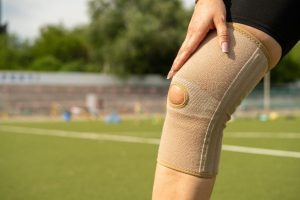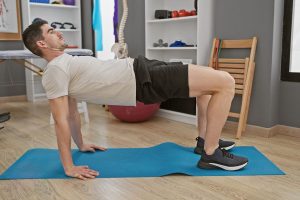If you’ve got chronically tight hamstrings, hips, or persistent pain around the hips or back, there’s a chance that it’s a result of the adaptive shortening of your muscles resulting from the excessive amount of sitting we do in our modern society.
Adaptive shortening refers to the physiological process where muscles and connective tissues generally shorten their length or become “tight” over time as a result of being chronically held in shortened positions. This typically occurs as a result of prolonged sitting or repetitive postural positions.
In this article, we’ll discuss what adaptive shortening is, help you understand the symptoms of adaptive shortening, and introduce a way to fix adaptive shortening if you’re experiencing discomfort.
Adaptive shortening symptoms
Adaptive shortening of the musculature around the hips, shoulders, and neck is extremely common, and most of us are likely experiencing some level of adaptive shortening as a result of our daily lives. Most of the time, we don’t begin to notice or take care of the issue until it starts causing problems.
The symptoms of adaptive shortening often first manifest as pain, specifically low back pain or hip pain.
Upon further inspection, we often find that the range of motion around the hips has been reduced. Additionally, tightness in the shoulders, neck, and upper back can be present as well.
This can be investigated by testing the flexibility specifically of the hamstrings and hip flexors, two muscle groups that are dramatically shortened in the sitting position.
Lastly, adaptive shortening may manifest as a feeling of stiffness around the hips, hamstrings, and hip flexors (musculature in the front of the hips).
Causes of adaptive shortening
The term “adaptive” refers to our muscle bellies and connective tissue adapting to the positions in which we place our bodies day to day. The most obvious position that we tend to “overuse” day-to-day is the seated position.
Take stock of your own day, and think about how many hours you sit. For instance, take a typical working person’s day:
- Upon awakening, most of us eat breakfast in a seated position
- We sit in our cars on the way to work
- We sit for 3-4 hours, working before an initial break
- We return from our break, and sit for 3-4 more hours
- We sit in our cars on the way home from work
- We eat dinner in a seated position
- We relax on the couch after dinner, in a seated (often slumped) position on a couch
The person above is likely in a seated position for a minimum of 10-12 hours per day! Now, consider the fact that many of us sleep on our sides, with our legs elevated. You guessed it: a “seated” laying position.
This results in certain muscle groups remaining in a shortened position almost all of the time, rarely (if ever) being lengthened.
Of course, this effect will be the most dramatic among individuals who place their bodies in seated positions for work, although it can also be pronounced among those of us who don’t sit for a living, such as amateur or professional athletes who engage in thousands of repetitions of similar movements for long periods of time.
Most commonly shortened muscle groups
Whether the culprit is excessive poor posture at work or repetitive motions in some kind of physical activity (or both!), the muscle groups most commonly associated with adaptive shortening include:
Hip flexors
Much has been written and said about shortened or tight hip flexors over the years. This one is almost certainly a direct result of prolonged periods of time spent sitting, although it can also result from large amounts of certain physical activities, like running or cycling. The psoas major, illiacus, and rectus femoris (one of the quadriceps muscles) are the common culprits.
Hamstrings
Another muscle group that will likely come as no surprise to you is the hamstrings. These muscles are often chronically shortened in those of us who sit for a living – and they’re a common source of stiffness and tightness. When the knee joint is flexed (bent) in a sitting position, the hamstring lies in a shortened position and assumes a shorter length over time.
Adductors
The adductors are a group of large muscles on the inside of the thigh that become chronically tightened when we sit, rather than squat, as our ancestors did.
Calf muscles
The gastrocnemius and soleus muscles in the calf are common culprits for adaptive shortening, especially from sitting.
Lats, shoulders, chest
For those of us who sit on a computer a lot, we’re likely hunching our shoulders forward, shortening the pectorals and dropping the shoulders down, shortening the large muscles under the armpits (latissimus dorsi). When these muscles are tight, it can make standing up straight feel difficult or even painful.
Neck muscles
The sternocleidomastoid, scalene, and upper trapezius muscles in the neck end up shortened as a result of our forward head posture. In general, we’re referring to the muscles on the sides and back of the neck.
How to fix adaptive muscle shortening
Though an in-depth guide for each of the above body parts would be beyond the scope of this article, we can provide some guidelines here.
First, it’s important to know that not all is lost. As we discussed in our “is sitting is the new smoking?” article, discontinuing sitting altogether is not necessarily the answer (nor is it even feasible for most of us). Rather than demonizing the activity of sitting, we should look to ways to lengthen and strengthen the shortened muscles to regain their lost mobility.
Once we’ve regained that mobility, we should consistently and regularly engage in activities to maintain that mobility. The good news is that maintaining almost any attribute of fitness is much easier than building it the first time.
In other words, a relatively high level of effort in the beginning will pay dividends over the long haul, as long as we’re willing to continue putting in a modicum of effort to maintain those attributes over time.
Guidelines for adaptive shortening treatment
In our article on how long it takes to improve flexibility, we outlined some basic guidelines for improving flexibility of any muscle group. The current literature suggests:
- Stretching around 30 seconds per stretch is optimal, increasing the duration doesn’t necessarily improve outcomes.
- Stretching each muscle group for 3-4 “sets” is a good recommendation per day.
- Stretching is safe to do daily.
In light of the above recommendations, we recommend you spend 30 seconds each engaging in the following stretches up to 3-4 times daily, in the beginning:
- Hip flexor stretches
- Quadriceps and hamstring stretches
- Quadratus lumborum (QL) stretches
- Adductor stretches
- Lat stretches
- Pectoral (chest) stretches
- Neck and upper trap stretches
Spending 30 seconds in each stretch should take you about 6-7 minutes if you move from exercise to exercise.
Quick tips for the long-term
As we’ve suggested above, this is something we need to commit to over the longer term. That said, here are some quick tips to help you as you move forward out of the initial phase:
- After a couple of weeks, you could back off to 2-3 sessions daily, or even one good session per day to maintain your mobility.
- If you struggle with stiffness in the morning, try doing your last session for the day right before you go to bed. You’ll sleep better and wake up with less stiffness in the morning.
- If you struggle with stiffness at work, try doing a session during your morning routine before work. You’ll feel better as you go throughout your day, and be less distracted by nagging pains.
The positive effects of counteracting adaptive shortening syndrome
Many individuals who have made a concerted effort to counteract their adaptive shortening find the difference to be dramatic. Some folks report great improvements in their pain/stiffness and basic mobility after just a few days.
Regardless, regaining your basic mobility takes time, but is very rewarding. Though mobility isn’t a “catch-all” solution for pain, it can also make basic tasks feel easier – things like picking up items off the floor, grabbing items off of high shelves, carrying objects to and from the car, etc.
A quick caveat before we wrap up
Also note that if you’ve got an injury, we recommend getting assessed by a trained physical therapist before you start any program of mobility, strength, or anything else.
The program outlined above can be very good for the basic, uninjured person who feels stiffness or low-level pain throughout the day. However, trying to use this as a DIY physical therapy solution has a high potential to backfire if you end up aggravating your injury.
Next steps
Adaptive shortening of key muscle groups is fairly straightforward to combat once we’ve identified the source of our issues and begun a concerted effort to:
- Regain lost mobility
- Maintain our newfound mobility (once we’ve achieved it)
In the next month, we’ll outline some of our favorite “office friendly” ways to stretch these muscles out during the day, separating them generally into upper body and lower body.

















